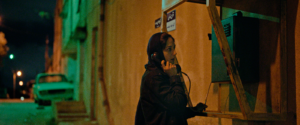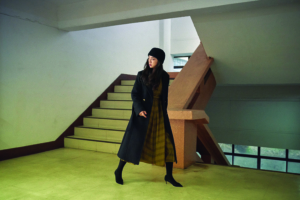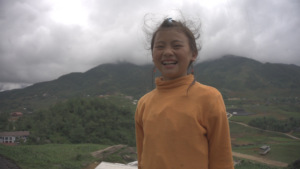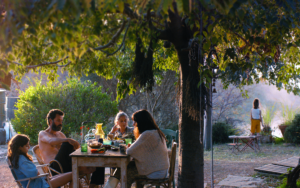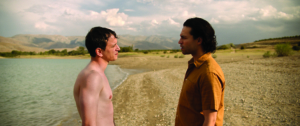There’s a scene in the documentary Starless Dreams (Mehrdad Oskouei, 2016) in which the subjects – a troop of teenage prisoners in girls juvie in Tehran – momentarily take command of the filming. They’re having a pizza-and-soft-drink party in celebration of a local holy day, and, grabbing the boom mic hanging overhead, the group breaks out in communal song, an off-the-cuff rendition of a Persian pop hit (the lyrics ‘unfair times have made me grow old / and tired of this worthless life’ hang heavily). Soon, a pair of the most outgoing girls – garrulous, boastful, lawless Shaghayegh and ‘class clown’ Hasrat – start interviewing each other, using plastic cups as microphone props, as if seizing control of the process through play.
‘Why is Uncle Mehrdad making this film about us?’ Hasrat asks. ‘We should’ve been making this film, not them,’ she adds, gesturing at the camera, at the whole crew of people in charge of how the girls’ stories will be told to the world. ‘If it were up to me,’ Shaghayegh considers, ‘I would make a film about our families.’
With his subsequent sister picture, Sunless Shadows (2019), Oskouei took this as a moment of inspiration, a leaping-off point for a continued exploration of these stories. In preparing for the film, Oskouei set up an unmanned camera in a room at Tehran’s Centre for Correction and Rehabilitation for Young Adults, turning it into a confessional. Here, the girls could speak directly to the camera, and, more importantly, make videos that would be shown to their mothers who are serving time, often on death row, in women’s prisons. The girls had told the filmmaker that, when visiting their mothers, they felt as if they didn’t have time to talk in depth, that looming over every conversation was a ticking clock. By addressing the camera, Oskouei says, ‘They can speak directly to their mothers without any censor[ing], without any worries.’[1]Interview partially conducted in English, with executive producer Siavash Jamali serving as interpreter for instances in which Oskouei spoke in Farsi.
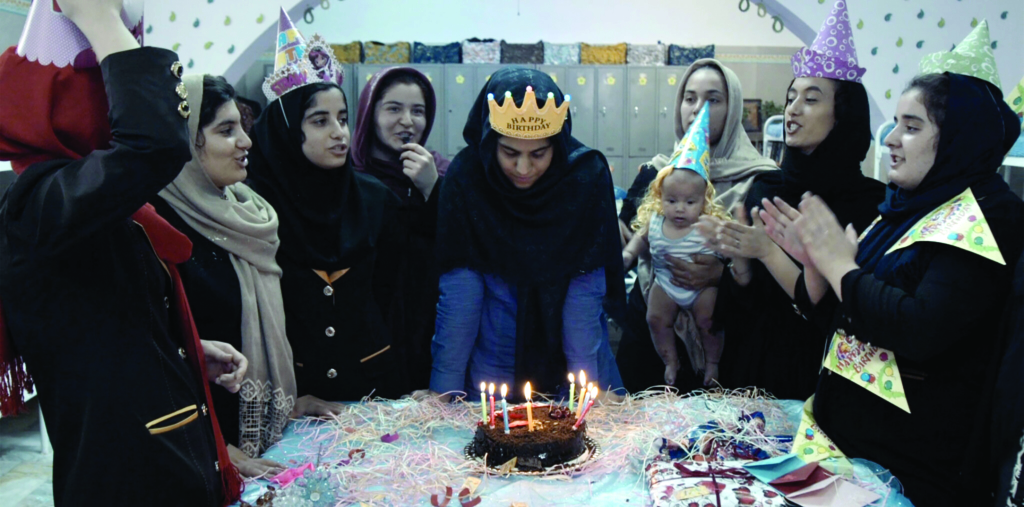
Giving his subjects the chance to film themselves also changed the traditional dynamics of documentary filmmaking. ‘It’s the difference between democracy and dictatorship,’ Oskouei says. ‘I want to give them more space, make it more democratic. For me, filmmaking isn’t you just shooting whatever you want, doing whatever you want to do. It’s good to share power.’
Oskouei has now made four documentaries inside juvenile-detention facilities: before Starless Dreams and Sunless Shadows were made in the one girls reformatory, It’s Always Late for Freedom (2007) and The Last Days of Winter (2011) were filmed inside the male wing of the same correctional centre. Oskouei traces his interest in exploring these institutions, and the many varied lives of the children within, back to his own youth. When he was growing up, his father and grandfather were both imprisoned for political reasons (Oskouei himself recently received a one-year suspended sentence from Iranian authorities for making a new film set in a prison for drug trafficking, which was only commuted when he paid off a ‘fine’).[2]See Bilge Ebiri, ‘Iranian Filmmaker Mehrdad Oskouei Awaits a Prison Sentence in Quarantine’, Vulture, 2 April 2020, <https://www.vulture.com/2020/04/iranian-filmmaker-mehrdad-oskoueis-dispatch-from-quarantine.html>, accessed 1 February 2021. When he was fifteen, following the bankruptcy of his father, Oskouei attempted suicide.[3]See Bilge Ebiri, ‘Discover Iran’s Most Important Documentary Filmmaker: Mehrdad Oskouei’, The Village Voice, 22 February 2018, <https://www.villagevoice.com/2018/02/22/discover-irans-most-important-documentary-filmmaker-mehrdad-oskouei/>, accessed 2 February 2021. ‘This is why I wanted to film young people in rehabilitation centres,’ he explains. ‘I wanted to know about their situations, what had led them to [where they were].’
These situations, and the told stories of woe, are all uniformly grim (Oskouei says he was in ‘physical pain’ hearing these accounts over and over, holding on to them for years through both productions). Girls in Starless Dreams have been brought into the world by meth addicts, forced into thievery or sex work, beaten and abused, molested by family members, refused schooling, either imprisoned in their own homes or cast out onto the streets. Many have practised self-harm, turned to drugs themselves; when a routine HIV test is undertaken at the facility, some are frightened they’ll test positive given a history of sharing needles. These things they speak of – abuse, incest, drug addiction – are huge taboos in Iran (‘They are red lines that you cannot cross,’ Oskouei offers, ‘but we try to push those lines’). Having come through those experiences, these subjects are scarred; many don’t want their families to know their whereabouts, and some have arrived at a place of total despair. ‘What’s your dream?’ Oskouei, from behind the camera, asks pale, strung-out, heavily scarred Khatereh. ‘To die,’ she replies, with an eerily sleepy look in her eyes. ‘I’m tired […] of living.’
Oskouei set up an unmanned camera in a room at Tehran’s Centre for Correction and Rehabilitation for Young Adults, turning it into a confessional.
‘This place is full of pain,’ says Somayeh, surveying the scene. ‘The pain drips from the walls.’ This pain is a shared currency among the girls: ‘Each one of them has experienced the same thing: an addicted father who pimps his daughter out for drugs,’ she reasons. Somayeh is surprised to still be alive – not because of her own drug use, but because she thought she would be executed ‘straight away’ for committing murder. ‘One night we decided to kill my father,’ she says, beginning her story, sitting on a bunk bed. Her father was an opium addict who beat his wife and daughters until, Somayeh says, ‘there [came] a point where you [couldn’t] take it anymore’.
Like the moment in which the girls take command of the camera, this moment, too, set the tenor of what was to come with Sunless Shadows. ‘Through [Starless Dreams],’ Oskouei says, ‘I came upon this topic: girls who murdered their closer family [members] – their father, brother, brother-in-law [or] husband.’ This includes Somayeh, a familiar face from the first film who returns in the second, where she delivers impassioned video letters to both her dead father and her mother, who is awaiting execution in a women’s prison.
These crimes are all shocking in their similarity: occurring as the response to years of abuse, with mothers and daughters often conspiring to kill a hated male family member. Whereas most films about murder – be they true-crime or fictionalised – seem prurient, Sunless Shadows functions as a series of difficult conversations, in which Oskouei isn’t a detached observer (or wannabe Sherlock) but an empathetic interlocutor. ‘Mehrdad was genuinely fascinated in talking to people who have committed murder and making a film about murder,’ says Sunless Shadows executive producer Siavash Jamali. ‘Because he tried to commit suicide when he was their age. And, when you commit suicide, you are also killing someone.’ Oskouei, he relays, ‘wanted to find out what happened in the lives of other people, what were their motivations, why they did what they did’.
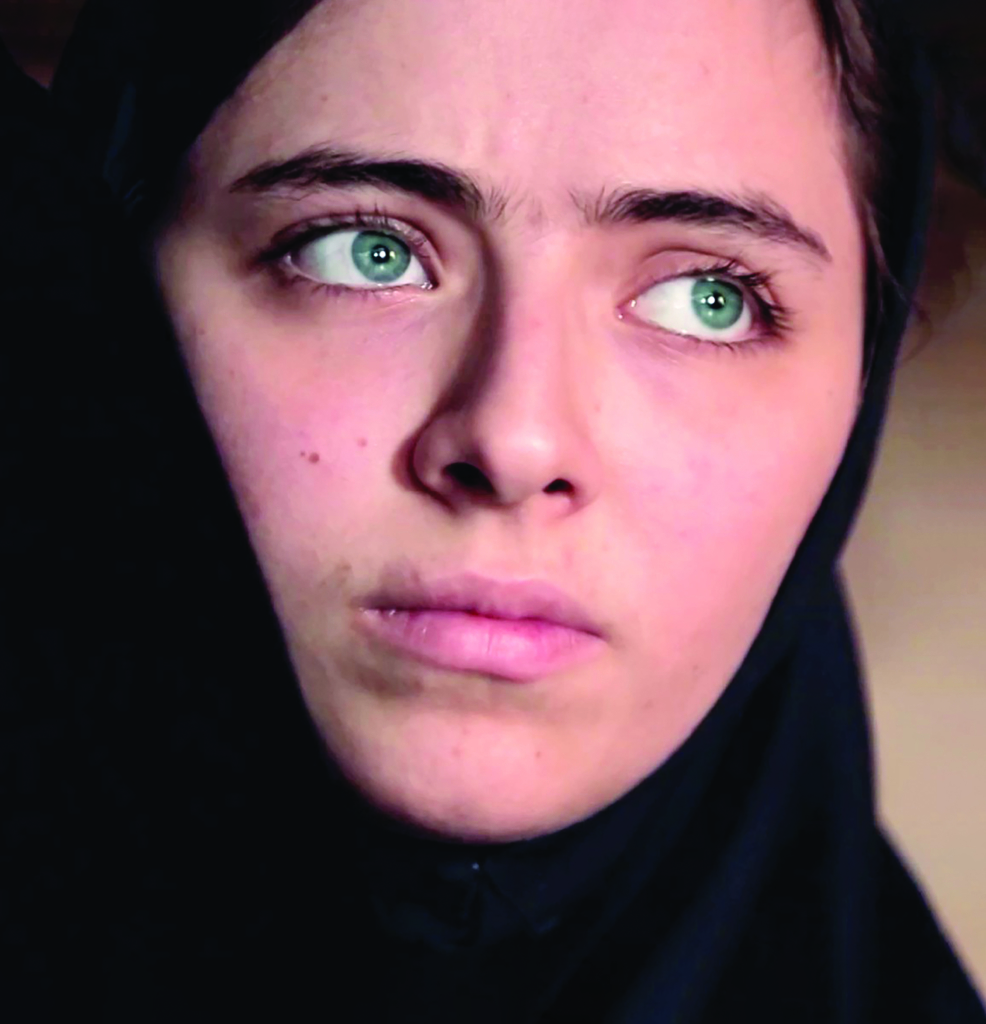
There’s the obvious refutation of stereotype, too, in the perpetrators of these ‘horrific crimes’ being ‘beautiful, kind girls’, as Jamali puts it. And there’s a greater sociopolitical theme at play in recounting these crimes, which come across as moments of insurrection, their occurrence an indictment of a society that views women as family property. While some of the girls were petty criminals long before participating in murder, others were model daughters; killing a family member is seen as a desperate answer to an impossible problem, the only way out of a hell upheld by Iranian law and society. ‘They don’t think about what will happen after they kill someone,’ Jamali offers.
They don’t foresee the repercussions or think about the consequences. They are just in such pain; all they are doing is trying to stop that pain […] In that moment that they are going to kill him, they don’t see the future. They just want him to be dead.
In Sunless Shadows, hearing the tales of murder (which often involve lethal poisoning via an offered drink, a method with medieval overtones) is not nearly as horrifying as hearing the stories of what led to the killings: the years of abuse the girls suffered, and how they felt trapped in their lives. This leads to one of the greater themes of the two pictures: that, beyond the walls of the prison, the greater prison is Iranian society, with the heavy legal restrictions it imposes on young women. ‘Wherever they are is a prison. Inside, they are in prison; but, outside, they are in prison, too,’ Jamali says. ‘They [would] like to get [a] release, but they know that what’s waiting outside isn’t their freedom.’
The most surprising quality of these documentaries, which, in writing, probably sound unbearably grim, is that they’re filled with as much joy and laughter as sadness and horror.
We hear phone calls in which inmates beg their families to help them, bring shoes to a court appearance, even let them see their own newborn children – all to no avail. Some are being taken to court by these same families, with aggrieved male relatives pushing for death penalties for their own kin. Sunless Shadows is dedicated to one of its subjects, Aida, who, after killing her husband, killed herself upon her release. Many don’t want to be discharged. In Starless Dreams, we hear from two separate girls who are desperate not to go back home, knowing that abuse will greet their arrival (‘My family is no good,’ says Sahar. ‘They’ll welcome me with chains and beating’; while Layla pleads, ‘If you give me back to [my family], they are going to chain me up’). When Somayeh, who appears in both films, talks of her post-release life in Sunless Shadows, she says it’s boring, joyless, no comparison to life on the inside. ‘I spent the best years of my life here,’ she says – not as lament, but celebration.
In prison, the girls feel safe – not just to speak out, but to be themselves. There’s an amazing scene near the end of Starless Dreams where they’re invited to listen to a visiting imam speak on religion. Instead, they ask him questions, grilling him on the entrenched sexism of Iran’s orthodox theocratic society, as well as airing their grievances about systemic misogyny: how society has devalued their literal worth (blood-money rates were, at the time of filming, higher for the taking of male lives than female lives[4]This discriminatory practice was effectively ended in 2019; see Tahereh Hadian-Jazy, ‘Blood Money Decision Advances Women’s Rights in Iran’, Atlantic Council website, 5 August 2019, <https://www.atlanticcouncil.org/blogs/iransource/blood-money-decision-advances-women-s-rights-in-iran/>, accessed 1 February 2021.); male ownership over children and wives; the legal system and judges who they feel did them wrong; the world that has denigrated them since birth. ‘Most girls that age don’t have the opportunity to ask those questions, aren’t able to freely talk to someone, don’t feel that they’re allowed to say those things,’ Oskouei relates. ‘They were asking big questions, smart questions – about God, about judgement, about laws […] I was struck by the thought that putting it at the end of the film [could] reveal different layers of that rehab centre.’
When imprisonment is preferable to life on the outside, it provokes questions about the world outside those walls. To expand on the old aphorism: you can judge Iranian society not just by how it treats its criminals, but also by how those criminals are treated when not locked up. Those former inmates who come back to visit are returning not just to revisit old friends, but to chase the feelings of security and camaraderie they found in this dormitory, where the girls sleep in rows in one big room. This phenomenon is found in the most surprising quality of these documentaries, which, in writing, probably sound unbearably grim: they’re filled with as much joy and laughter as sadness and horror. Part of this is a filmmaking choice (Oskouei says he ‘had to make a movie that people can watch [and] balance sadness with humanity, so that [viewers] can tolerate it’), but much of it comes from this correctional facility being an unexpected enclave, sheltering girls from a staunchly patriarchal society.
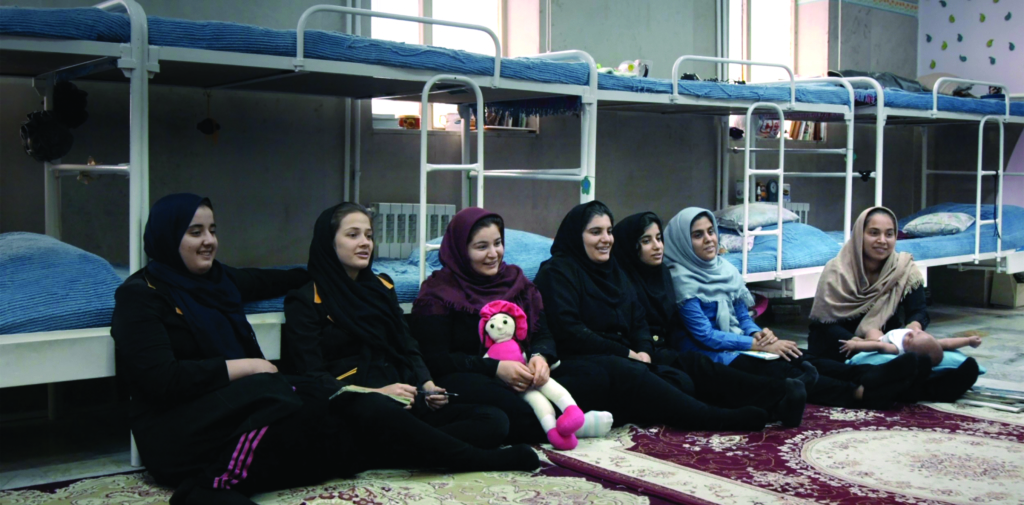
We see the girls throwing snowballs and making snowmen in winter, having a water fight in summer. They play volleyball and dodgeball, truth or dare, and games with dolls. They raise ducklings in the prison garden and tend to plants in a greenhouse. They take guided meditations, learn English and poetry and bookkeeping, and have parties for birthdays and for girls getting released (even if the latter celebrations can, sometimes, seem like wakes). It’s at a party that they feel empowered to momentarily take charge of the filmmaking process, intervening on behalf of themselves, aware of the power of storytelling. When the girls were speaking to camera in Sunless Shadows, telling their stories themselves, Oskouei could see that they intuitively grasped the macro themes at play, and the power of the camera (and of cinema). ‘It was not just for their mothers, or even just for me,’ he says, of their confessions. ‘It is for all society. They are talking to everyone. The camera is just there as a kind of witness.’
For both director and subjects, there’s reason to hope that these films can make a material difference, both for the lives of the girls (Oskouei tells me that he helped sponsor further education for several, including Somayeh, upon their release) and for Iranian society. Though It’s Always Late for Freedom and The Last Days of Winter didn’t find distribution in Iran, Oskouei has described them as having ‘had an emotional impact’ on authorities,[5]Mehrdad Oskouei, quoted in Amir Soltani, ‘“By the Time They Banished Me, I’d Already Finished Filming”: An Interview with Mehrdad Oskouei’, Hazlitt, 3 March 2016, <https://hazlitt.net/feature/time-they-banished-me-id-already-finished-filming-interview-mehrdad-oskouei>, accessed 22 February 2021. and the aftermath of their release has coincided with some thawing in Iranian legislation regarding sentencing for juvenile offenders. Starless Dreams was hugely successful and acclaimed, winning over forty awards, screening at over 130 international festivals and being shown to local decision-makers, politicians and NGOs. Despite the legal troubles Oskouei has faced as a result of his current project, he still hopes he can use Starless Dreams and Sunless Shadows to agitate for social change, working with foreign NGOs and local politicians to advance the rights of young women. In these films, the problems facing these girls can feel intractable; the greater prison of Iranian society, inescapable. But the filmmaker still holds out hope. ‘It’s hard to make the world a better place,’ Oskouei says, ‘but we have to try.’
Endnotes
| 1 | Interview partially conducted in English, with executive producer Siavash Jamali serving as interpreter for instances in which Oskouei spoke in Farsi. |
|---|---|
| 2 | See Bilge Ebiri, ‘Iranian Filmmaker Mehrdad Oskouei Awaits a Prison Sentence in Quarantine’, Vulture, 2 April 2020, <https://www.vulture.com/2020/04/iranian-filmmaker-mehrdad-oskoueis-dispatch-from-quarantine.html>, accessed 1 February 2021. |
| 3 | See Bilge Ebiri, ‘Discover Iran’s Most Important Documentary Filmmaker: Mehrdad Oskouei’, The Village Voice, 22 February 2018, <https://www.villagevoice.com/2018/02/22/discover-irans-most-important-documentary-filmmaker-mehrdad-oskouei/>, accessed 2 February 2021. |
| 4 | This discriminatory practice was effectively ended in 2019; see Tahereh Hadian-Jazy, ‘Blood Money Decision Advances Women’s Rights in Iran’, Atlantic Council website, 5 August 2019, <https://www.atlanticcouncil.org/blogs/iransource/blood-money-decision-advances-women-s-rights-in-iran/>, accessed 1 February 2021. |
| 5 | Mehrdad Oskouei, quoted in Amir Soltani, ‘“By the Time They Banished Me, I’d Already Finished Filming”: An Interview with Mehrdad Oskouei’, Hazlitt, 3 March 2016, <https://hazlitt.net/feature/time-they-banished-me-id-already-finished-filming-interview-mehrdad-oskouei>, accessed 22 February 2021. |

